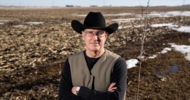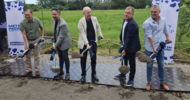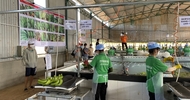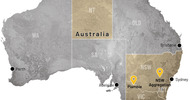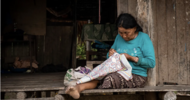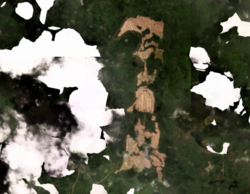
Mongabay | 1 December 2023
Poverty and plantations: Nigerian reserve struggles against the odds
by Orji Sunday
Situated in western Nigeria, some 70 kilometers (113 miles) east of Nigeria’s commercial city of Lagos, Oluwa Forest Reserve is facing severe pressure from smallholder farmers and big plantations. On Highway A121, a major route between Lagos and the city of Ore that bissects the reserve, Mongabay observed heavily loaded trucks and motorbikes driving plantain or banana bunches, bagged cocoa pods and logged timber out of the reserve to nearby cities, sawmills and markets.
Alhough Oluwa was gazetted in 1918, weak protection means that thousands of farmers have taken over much of the reserve, converting forest into farms and camps. A typical camp is dotted with mud bungalows, roofed by thatch or zinc, in addition to mosques, churches, pubs, community halls and, in some cases, palm oil mills.
Farmers told Mongabay during a 2021 reporting trip that settlers were required to pay around 10,000–12,000 naira ($12–14.30) per hectare to forest officers for the right to retain their stakes in the reserve. Only previously established farms, not new farms, are entitled to this deal, according to officials from the Ondo State Ministry of Agriculture and Natural Resources.
Forest officers patrol settlements, issue eviction notices, resolve disputes, destroy new farms and arrest defaulting farmers. But despite these efforts, Oluwa’s forests are continuing to disappear as encroachment outpaces enforcement.
In the past two decades, from 2002 to 2022, Oluwa’s total area of humid primary forest has declined by 17%, according to satellite data from Global Forest Watch. Preliminary data for 2023 show clearing continuing to eat away at the reserve’s old growth forest.
Camp leaders say many of those flooding into Oluwa are young people and skilled artisans who have few other prospects and see Oluwa’s cheap land, fertile soil, abundant rain and moderate temperatures as an escape from cities where crippling poverty, high rates of unemployment and record inflation is the norm.
“This place has helped a lot of poor families,” said Ayodele Aina, who has farmed in the reserve for more than four decades. “For some of us, this is the only means of livelihood we know. And since there are no jobs in the cities, a lot of youths are returning to farming.”
In November 2023, some 10,000 farmers in the Odigbo sector of the reserve protested their forced eviction and petitioned the state governor, Rotimi Akeredolu, to rescind the eviction decision. In May 2023, the farmers obtained an injunction from the Ore division of the Ondo State High Court, temporarily restraining the government from evicting them. They also argue that they complied with the financial obligation of their stay by paying all necessary dues and levies.
Plantations: A growing threat
Smallholders aren’t solely to blame for the loss of Oluwa’s forests. Satellite imagery shows the telltale pattern of industrial-scale plantations expanding throughout the reserve. While most of these were established in parts of the reserve that had been previously deforested, satellite imagery and data show several large clearings have expanded into primary forest in 2023.
In 2021, Mongabay field visits uncovered signs of expanding industrial agriculture, and satellite data show the bulk of large-scale forest clearing taking place in plantation areas. Bambi Farms Ltd., for example, a private firm headquartered in Okeigbo in Nigeria’s state of Ondo State, was granted a concession of 5,000 hectares of land within Oluwa in 2018 and claims to partner with 450 smallholder farmers as part of an ongoing outgrower scheme.
Mongabay also observed signs reading “Fayok Glorious Nigeria Enterprise” and “West Africa Forest Plantations Ltd.” while visiting Oluwa. While no functioning websites or active social media accounts could be found for these three companies, a LinkedIn profile purportedly of former West Africa Forest Plantations CEO Ayo Ighodaro describes the company as “the largest sustainable forestry and value-added timber products company in Nigeria, poised for dramatic growth over the next few years.”
SAO Agro-Allied Service Limited, which identifies as a “social impact project developer operating exclusively in the agriculture sector in Africa” according to the company’s LinkedIn profile, was granted 100,000 hectares by the Ondo state government to cultivate oil palm in the state, according to local media. But some portions of the company’s concession, farmers say, overlap with smallholder cocoa, plantain, and banana farms that belong to thousands of subsistence farmers within Oluwa and other forest reserves. SAO Agro-Allied Service did respond to an emailed request for comment.
Multiple sources said Oluwa’s fate is tied to political enigma. There is, for instance, an inconsistent approach to conservation efforts and policies in the reserve as different government administrations come and go, according to Ojo Aduke, an official of the forestry department. She also claimed that the agency is stymied by insufficient funding and constant political interference, literally reducing it into a mere advisory body to the administration in power.
“It is one thing for us to advise the government, but it is another thing for them to take heed. We cannot force our opinion on the government. Government is there to make its own decision,” Aduke told Mongabay. “But when you have passion for a cause, and you have been into it for a long time and you see it being destroyed, you would not be happy. I am not happy at all.”
While the reserve is providing an economic lifeline for thousands of people, conservationists warn its biodiversity is at grave risk. The reserve’s 800-some square kilometers area is home to diverse wildlife, including red-capped mangabeys (Cercocebus torquatus), Nigerian white-throated guenons (Cercopithecus erythrogaster pococki), white-bellied pangolins (Phataginus tricuspis) and yellow-casqued hornbills (Ceratogymna elata).
Oluwa’s most iconic resident is the endangered Nigeria-Cameroon chimpanzee (Pan troglodytes ellioti). However, the current status of chimps in Oluwa is unclear. In 2009, a survey study conducted across southwestern Nigeria by researcher and biodiversity specialist Elizabeth Greengrass and published in the journal Primate Conservation noted that chimpanzees might still have inhabited parts of the forest, despite a sharp decline in population size and distribution.
“My results suggest that chimpanzees in southwest Nigeria are now on the brink of extinction,” Greengrass concluded in her study. “Unless effective action is taken, they will be extinct within the next few years in most of the sites where they were found to remain during this survey.”
Three years later, in 2012, a study conducted by professors Babafemi Ogunjemite and Olaniyi Oluwatobi at Nigeria’s Federal University of Technology Akure and published in the International Journal of Development and Sustainability showed that chimpanzees were restricted to a small, central portion of the reserve about 39.22 sq km (15.14 sq mi) in size, or a little over 5% of the reserve’s area.
The researchers wrote that farms, hunting and logging threaten chimps that potentially remain in Oluwa. In 2021, Mongabay uncovered how the reserve’s logged trees feed large sawmills in the state capital of Akure, as well as furniture needs in the nearby cities of Ore, Sagamu, Lagos, Ibadan and Ijebu-ode. Several trucks loaded with logs emerging from various trails in the Ore axis of the reserve regularly ply or are parked along the busy Ore-Lagos highway.
Smoked bushmeat is often displayed for sale on the roadside, as well. Despite a growing culture of livestock breeding, settlers in the reserve say they trap and kill various kinds of monkeys, as well as greater cane rats (Thryonomys swinderianus), antelope, porcupines and pangolins. Bushmeat is promoted locally for taste, purported medicinal value and use in traditional rites and rituals.
Experts and researchers at the Federal University of Technology Akure in the southwestern Nigerian state of Akure regularly visit and conduct research in the reserve. They told Mongabay that Oluwa is now deeply fragmented and its fauna is likely suffering from isolation leading to local extinction as gene flow between populations is inhibited. They say habitat in Oluwa is also on the verge of being severed from adjoining Shasha and Omo reserves, home to a dwindling population of forest elephants (Loxodonta cyclotis) and other iconic species.
Conflict erupts
In early November a protest broke out as farmers reportedly resisted the forceful takeover of their farms by armed members of Amoketun, a regional security unit that operates in southwest Nigeria. Government sources, quoted by local press, say the government wants to take back full control of the reserve in order to eliminate kidnappers, terrorists, ritual killers and armed robbers, who have turned the forest into a hideout and stronghold.
Farmers interviewed by Mongabay said that Oluwa and other adjoining forests are becoming increasingly unsafe and dangerous. They admit that criminal groups have raided and robbed farm settlements, and this has deterred researchers, conservationists and forest officers from accessing certain parts of the reserve.
Sources say there is a new, additional threat on the horizon: real estate development. Adebayo Moshood, a researcher at the Federal University of Technology, told Mongabay that estate developers have mapped and cleared large portions of the reserve for building projects.
Researchers interviewed by Mongabay, including Moshood, said they believe that at the current rate of destruction, it’s only a matter of time before Oluwa vanishes into history — along with many of Nigeria’s other embattled forest reserves.
“Nothing is being done to sustain the forest. And the only reason there is still a remnant of the forest is because the level of urbanization is relatively low. If it were to be situated in, say, Ibadan, Enugu, Lagos, or Port Harcourt, I believe it would have been long gone,” he told Mongabay over the phone.



